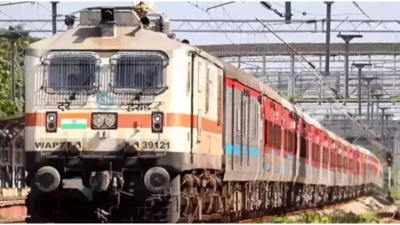- News
- Business News
- India Business News
- Railways okays plan to double manufacture of non-AC train coaches to 10,000 in 2 years
Trending
Railways okays plan to double manufacture of non-AC train coaches to 10,000 in 2 years

NEW DELHI: Indian Railways on Thursday approved the programme to double manufacturing of non-AC train coaches to around 10,000 in the next two years amid reports of long waiting list of tickets and criticism of crowding in unreserved and sleeper coaches of long-distance trains. Over 50% of these will be bogies with general seating facilities and more than one-third will be sleeper coaches.
In the past two financial years, around 4,900 such non-AC coaches were manufactured.Currently, railways has around 55,000 non-AC coaches and with the new production, there will be an 18% growth by March 2026, enabling the national transporter to cater to the growing demand.
As per the approved plan, 2,605 general coaches (GS) including for the newly introduced Amrit Bharat trains will be ready by March 2025. Similarly, 1,470 non-AC sleeper coaches including for Amrit Bharat trains will be manufactured this year. Amrit Bharat trains are fully non-AC rakes and will primarily ply on routes that have high demand of migrant workers. Currently, only two such trains are in operation.
In 2025-26, the railways will produce 2,710 GS coaches and 1,910 non-AC sleeper bogies for both normal and Amrit Barat trains, sources said. They added these will cater to high demand of passengers on long routes.
Officials said more availability of non-AC coaches will enable railways to add such bogies in trains that have less than 24 coaches. To deal with the summer rush, the railways had added such coaches to regular trains to carry more passengers. “Some of these coaches will also be utilised in new trains that would be introduced,” said an official.
“The demand for rail service is dynamic and decreases/ increases depending upon seasonal variations and growth of passenger traffic. The requirement of the coaches is based on these factors and has been included in the annual coach production programme. The production of coaches normally commensurate with the requirement,” an official said.
In the past two financial years, around 4,900 such non-AC coaches were manufactured.Currently, railways has around 55,000 non-AC coaches and with the new production, there will be an 18% growth by March 2026, enabling the national transporter to cater to the growing demand.
As per the approved plan, 2,605 general coaches (GS) including for the newly introduced Amrit Bharat trains will be ready by March 2025. Similarly, 1,470 non-AC sleeper coaches including for Amrit Bharat trains will be manufactured this year. Amrit Bharat trains are fully non-AC rakes and will primarily ply on routes that have high demand of migrant workers. Currently, only two such trains are in operation.
In 2025-26, the railways will produce 2,710 GS coaches and 1,910 non-AC sleeper bogies for both normal and Amrit Barat trains, sources said. They added these will cater to high demand of passengers on long routes.
The approval for manufacturing GS and sleeper coaches for Amrit Bharat trains gains significance as the govt has planned to roll out around 50 such trains during the financial year and more in the next year. It is finalising the advanced features in Amrit Bharat trains before the mass production starts.
Officials said more availability of non-AC coaches will enable railways to add such bogies in trains that have less than 24 coaches. To deal with the summer rush, the railways had added such coaches to regular trains to carry more passengers. “Some of these coaches will also be utilised in new trains that would be introduced,” said an official.
“The demand for rail service is dynamic and decreases/ increases depending upon seasonal variations and growth of passenger traffic. The requirement of the coaches is based on these factors and has been included in the annual coach production programme. The production of coaches normally commensurate with the requirement,” an official said.
End of Article
FOLLOW US ON SOCIAL MEDIA















